Analysis of Accounting and Financial Crisis Issues in The Big Short
VerifiedAdded on 2020/05/28
|8
|1974
|76
Report
AI Summary
This report provides an in-depth analysis of the accounting and ethical issues presented in the movie 'The Big Short,' which depicts the events leading up to the 2008 financial crisis. It explores the deregulation of the financial industry, the role of securitization, and the growth of subprime mortgages as key factors contributing to the crisis. The report highlights unethical practices, such as insider information and manipulation of the bond system by financial institutions and mortgage brokers. It also discusses the impact of these issues on the economy, including the collapse of hedge funds and the housing bubble. Furthermore, it examines the Australian accounting standards, emphasizing the importance of transparency and ethical guidelines in the financial environment. The report concludes with recommendations for the government to ensure ethical financial practices and the convergence of accounting standards with international best practices.
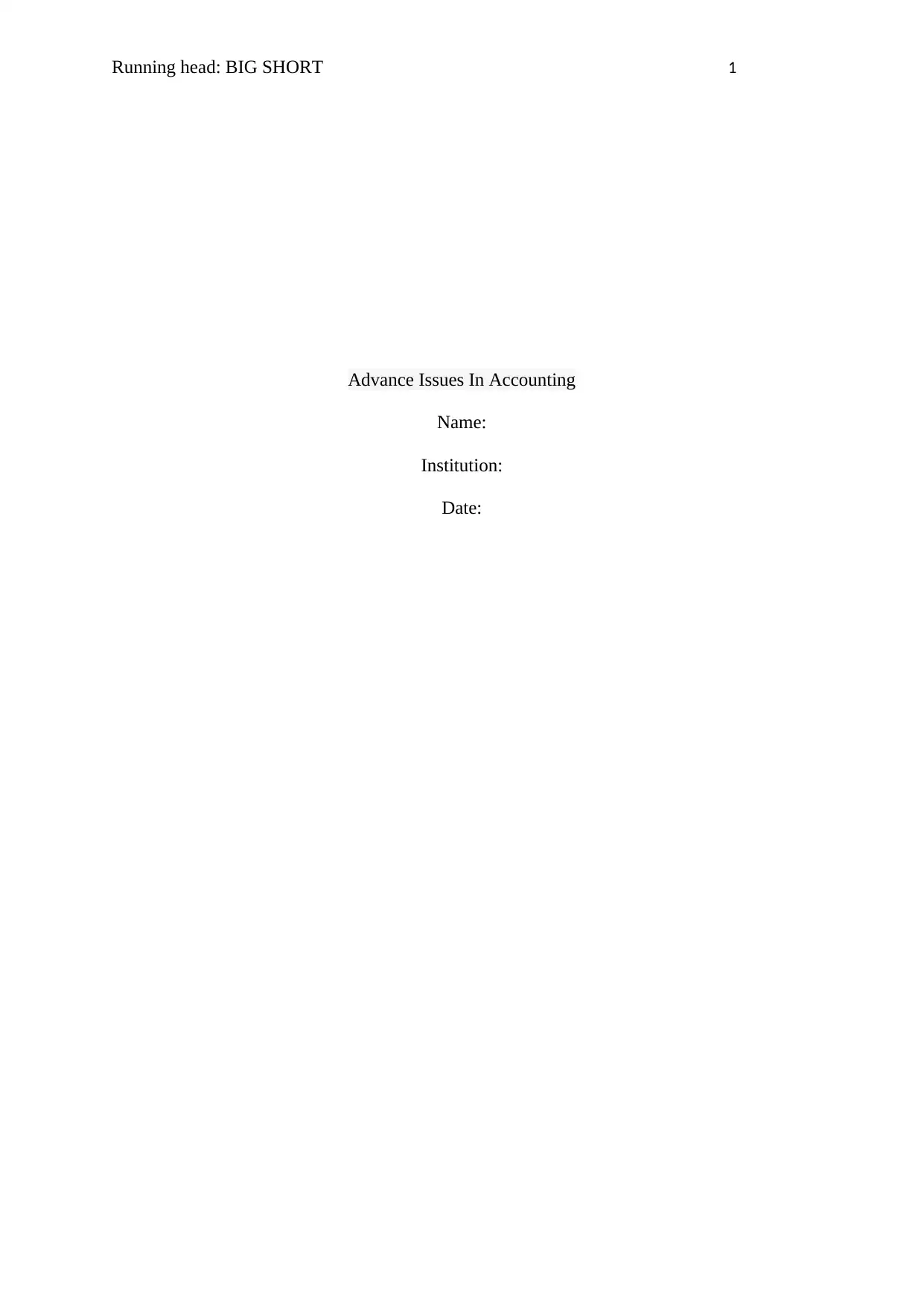
Running head: BIG SHORT 1
Advance Issues In Accounting
Name:
Institution:
Date:
Advance Issues In Accounting
Name:
Institution:
Date:
Paraphrase This Document
Need a fresh take? Get an instant paraphrase of this document with our AI Paraphraser
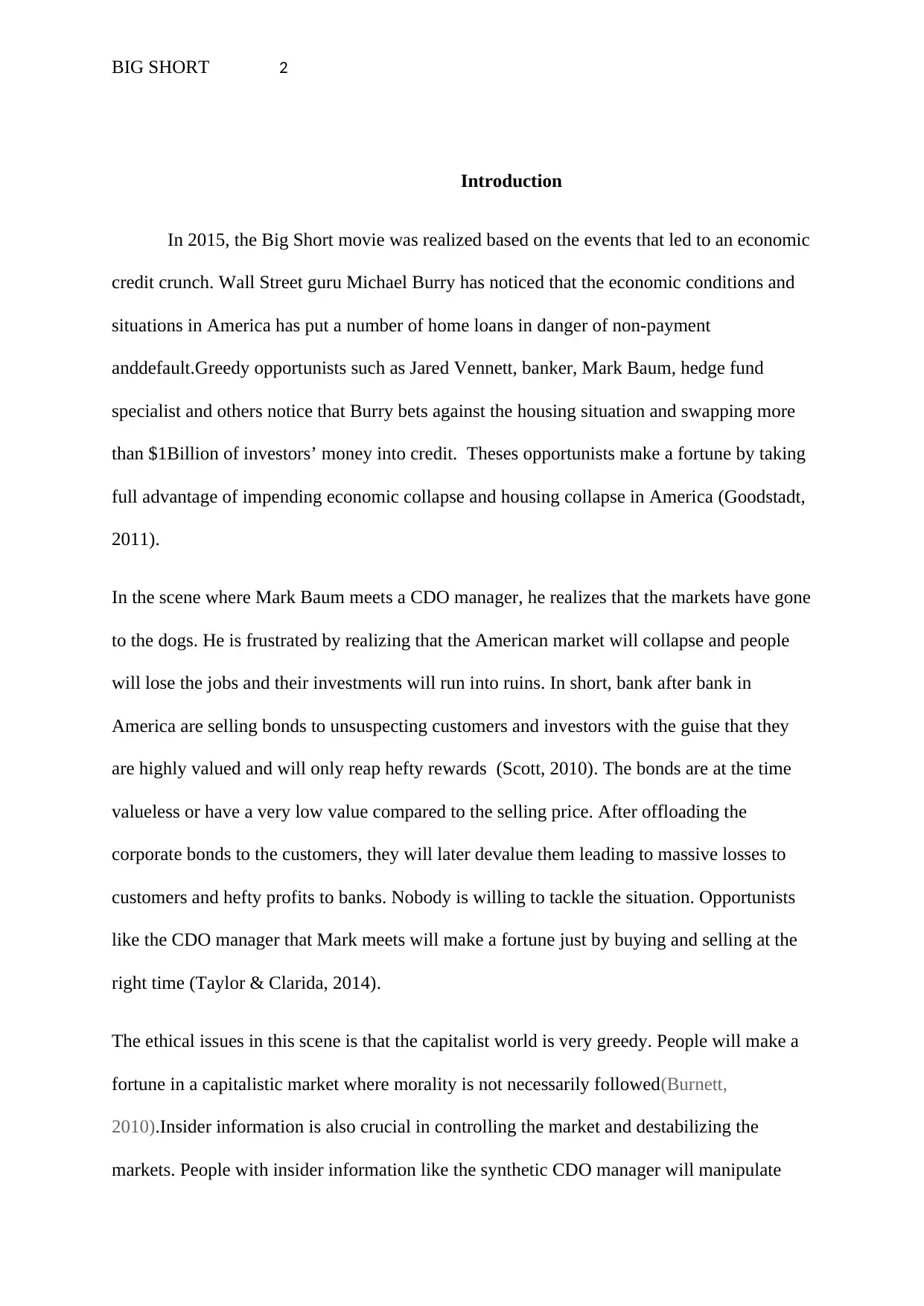
BIG SHORT 2
Introduction
In 2015, the Big Short movie was realized based on the events that led to an economic
credit crunch. Wall Street guru Michael Burry has noticed that the economic conditions and
situations in America has put a number of home loans in danger of non-payment
anddefault.Greedy opportunists such as Jared Vennett, banker, Mark Baum, hedge fund
specialist and others notice that Burry bets against the housing situation and swapping more
than $1Billion of investors’ money into credit. Theses opportunists make a fortune by taking
full advantage of impending economic collapse and housing collapse in America (Goodstadt,
2011).
In the scene where Mark Baum meets a CDO manager, he realizes that the markets have gone
to the dogs. He is frustrated by realizing that the American market will collapse and people
will lose the jobs and their investments will run into ruins. In short, bank after bank in
America are selling bonds to unsuspecting customers and investors with the guise that they
are highly valued and will only reap hefty rewards (Scott, 2010). The bonds are at the time
valueless or have a very low value compared to the selling price. After offloading the
corporate bonds to the customers, they will later devalue them leading to massive losses to
customers and hefty profits to banks. Nobody is willing to tackle the situation. Opportunists
like the CDO manager that Mark meets will make a fortune just by buying and selling at the
right time (Taylor & Clarida, 2014).
The ethical issues in this scene is that the capitalist world is very greedy. People will make a
fortune in a capitalistic market where morality is not necessarily followed(Burnett,
2010).Insider information is also crucial in controlling the market and destabilizing the
markets. People with insider information like the synthetic CDO manager will manipulate
Introduction
In 2015, the Big Short movie was realized based on the events that led to an economic
credit crunch. Wall Street guru Michael Burry has noticed that the economic conditions and
situations in America has put a number of home loans in danger of non-payment
anddefault.Greedy opportunists such as Jared Vennett, banker, Mark Baum, hedge fund
specialist and others notice that Burry bets against the housing situation and swapping more
than $1Billion of investors’ money into credit. Theses opportunists make a fortune by taking
full advantage of impending economic collapse and housing collapse in America (Goodstadt,
2011).
In the scene where Mark Baum meets a CDO manager, he realizes that the markets have gone
to the dogs. He is frustrated by realizing that the American market will collapse and people
will lose the jobs and their investments will run into ruins. In short, bank after bank in
America are selling bonds to unsuspecting customers and investors with the guise that they
are highly valued and will only reap hefty rewards (Scott, 2010). The bonds are at the time
valueless or have a very low value compared to the selling price. After offloading the
corporate bonds to the customers, they will later devalue them leading to massive losses to
customers and hefty profits to banks. Nobody is willing to tackle the situation. Opportunists
like the CDO manager that Mark meets will make a fortune just by buying and selling at the
right time (Taylor & Clarida, 2014).
The ethical issues in this scene is that the capitalist world is very greedy. People will make a
fortune in a capitalistic market where morality is not necessarily followed(Burnett,
2010).Insider information is also crucial in controlling the market and destabilizing the
markets. People with insider information like the synthetic CDO manager will manipulate
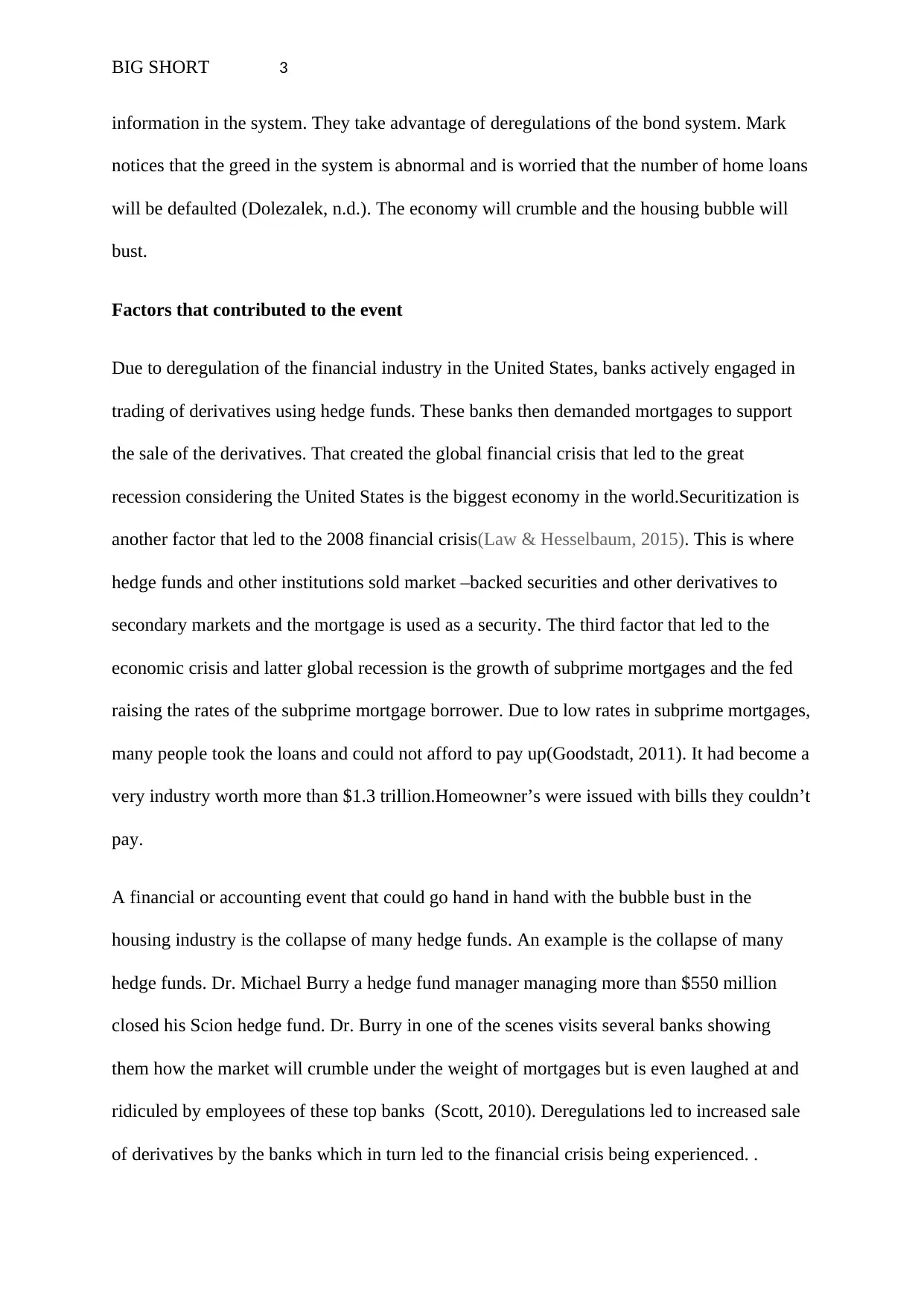
BIG SHORT 3
information in the system. They take advantage of deregulations of the bond system. Mark
notices that the greed in the system is abnormal and is worried that the number of home loans
will be defaulted (Dolezalek, n.d.). The economy will crumble and the housing bubble will
bust.
Factors that contributed to the event
Due to deregulation of the financial industry in the United States, banks actively engaged in
trading of derivatives using hedge funds. These banks then demanded mortgages to support
the sale of the derivatives. That created the global financial crisis that led to the great
recession considering the United States is the biggest economy in the world.Securitization is
another factor that led to the 2008 financial crisis(Law & Hesselbaum, 2015). This is where
hedge funds and other institutions sold market –backed securities and other derivatives to
secondary markets and the mortgage is used as a security. The third factor that led to the
economic crisis and latter global recession is the growth of subprime mortgages and the fed
raising the rates of the subprime mortgage borrower. Due to low rates in subprime mortgages,
many people took the loans and could not afford to pay up(Goodstadt, 2011). It had become a
very industry worth more than $1.3 trillion.Homeowner’s were issued with bills they couldn’t
pay.
A financial or accounting event that could go hand in hand with the bubble bust in the
housing industry is the collapse of many hedge funds. An example is the collapse of many
hedge funds. Dr. Michael Burry a hedge fund manager managing more than $550 million
closed his Scion hedge fund. Dr. Burry in one of the scenes visits several banks showing
them how the market will crumble under the weight of mortgages but is even laughed at and
ridiculed by employees of these top banks (Scott, 2010). Deregulations led to increased sale
of derivatives by the banks which in turn led to the financial crisis being experienced. .
information in the system. They take advantage of deregulations of the bond system. Mark
notices that the greed in the system is abnormal and is worried that the number of home loans
will be defaulted (Dolezalek, n.d.). The economy will crumble and the housing bubble will
bust.
Factors that contributed to the event
Due to deregulation of the financial industry in the United States, banks actively engaged in
trading of derivatives using hedge funds. These banks then demanded mortgages to support
the sale of the derivatives. That created the global financial crisis that led to the great
recession considering the United States is the biggest economy in the world.Securitization is
another factor that led to the 2008 financial crisis(Law & Hesselbaum, 2015). This is where
hedge funds and other institutions sold market –backed securities and other derivatives to
secondary markets and the mortgage is used as a security. The third factor that led to the
economic crisis and latter global recession is the growth of subprime mortgages and the fed
raising the rates of the subprime mortgage borrower. Due to low rates in subprime mortgages,
many people took the loans and could not afford to pay up(Goodstadt, 2011). It had become a
very industry worth more than $1.3 trillion.Homeowner’s were issued with bills they couldn’t
pay.
A financial or accounting event that could go hand in hand with the bubble bust in the
housing industry is the collapse of many hedge funds. An example is the collapse of many
hedge funds. Dr. Michael Burry a hedge fund manager managing more than $550 million
closed his Scion hedge fund. Dr. Burry in one of the scenes visits several banks showing
them how the market will crumble under the weight of mortgages but is even laughed at and
ridiculed by employees of these top banks (Scott, 2010). Deregulations led to increased sale
of derivatives by the banks which in turn led to the financial crisis being experienced. .
⊘ This is a preview!⊘
Do you want full access?
Subscribe today to unlock all pages.

Trusted by 1+ million students worldwide
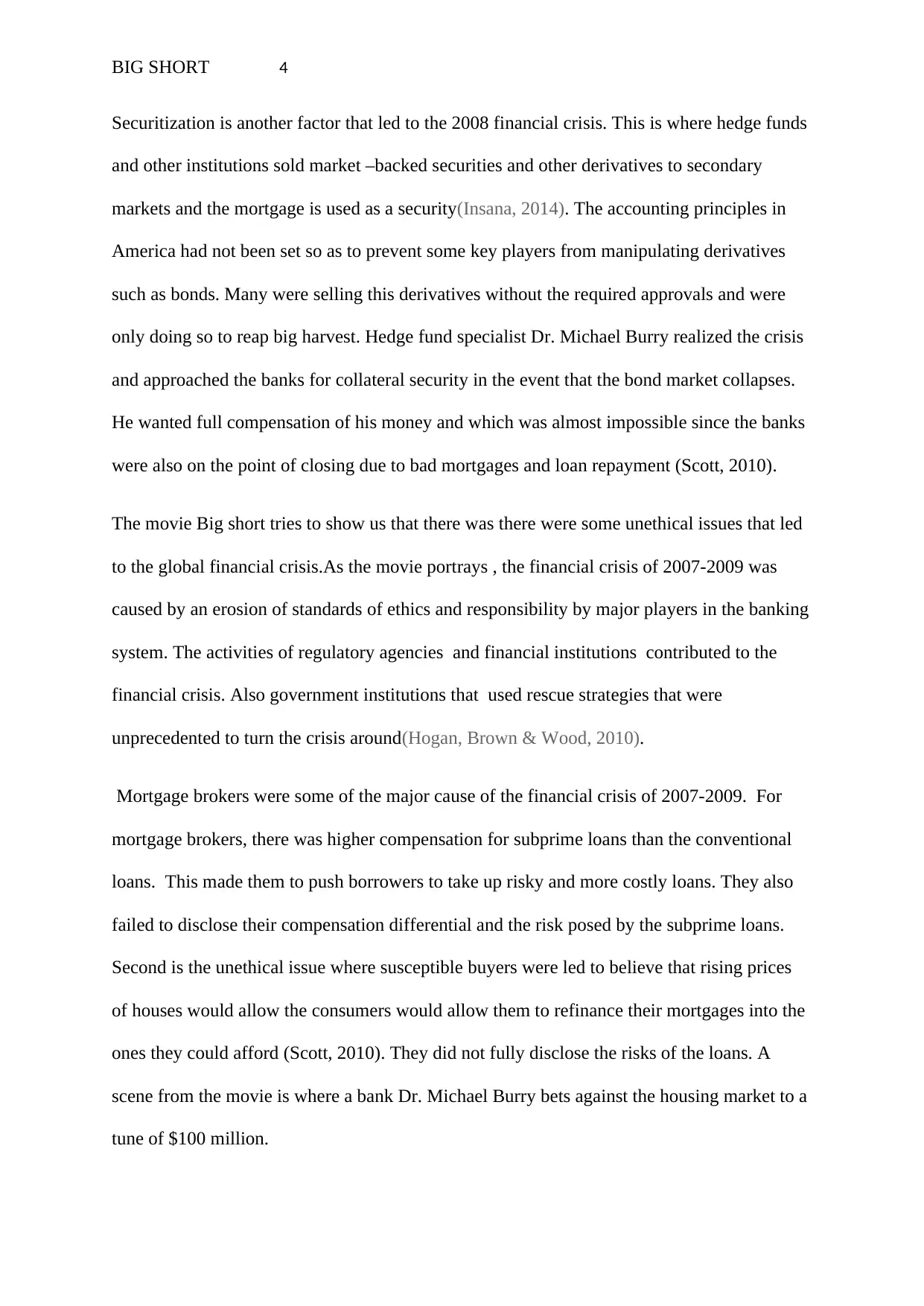
BIG SHORT 4
Securitization is another factor that led to the 2008 financial crisis. This is where hedge funds
and other institutions sold market –backed securities and other derivatives to secondary
markets and the mortgage is used as a security(Insana, 2014). The accounting principles in
America had not been set so as to prevent some key players from manipulating derivatives
such as bonds. Many were selling this derivatives without the required approvals and were
only doing so to reap big harvest. Hedge fund specialist Dr. Michael Burry realized the crisis
and approached the banks for collateral security in the event that the bond market collapses.
He wanted full compensation of his money and which was almost impossible since the banks
were also on the point of closing due to bad mortgages and loan repayment (Scott, 2010).
The movie Big short tries to show us that there was there were some unethical issues that led
to the global financial crisis.As the movie portrays , the financial crisis of 2007-2009 was
caused by an erosion of standards of ethics and responsibility by major players in the banking
system. The activities of regulatory agencies and financial institutions contributed to the
financial crisis. Also government institutions that used rescue strategies that were
unprecedented to turn the crisis around(Hogan, Brown & Wood, 2010).
Mortgage brokers were some of the major cause of the financial crisis of 2007-2009. For
mortgage brokers, there was higher compensation for subprime loans than the conventional
loans. This made them to push borrowers to take up risky and more costly loans. They also
failed to disclose their compensation differential and the risk posed by the subprime loans.
Second is the unethical issue where susceptible buyers were led to believe that rising prices
of houses would allow the consumers would allow them to refinance their mortgages into the
ones they could afford (Scott, 2010). They did not fully disclose the risks of the loans. A
scene from the movie is where a bank Dr. Michael Burry bets against the housing market to a
tune of $100 million.
Securitization is another factor that led to the 2008 financial crisis. This is where hedge funds
and other institutions sold market –backed securities and other derivatives to secondary
markets and the mortgage is used as a security(Insana, 2014). The accounting principles in
America had not been set so as to prevent some key players from manipulating derivatives
such as bonds. Many were selling this derivatives without the required approvals and were
only doing so to reap big harvest. Hedge fund specialist Dr. Michael Burry realized the crisis
and approached the banks for collateral security in the event that the bond market collapses.
He wanted full compensation of his money and which was almost impossible since the banks
were also on the point of closing due to bad mortgages and loan repayment (Scott, 2010).
The movie Big short tries to show us that there was there were some unethical issues that led
to the global financial crisis.As the movie portrays , the financial crisis of 2007-2009 was
caused by an erosion of standards of ethics and responsibility by major players in the banking
system. The activities of regulatory agencies and financial institutions contributed to the
financial crisis. Also government institutions that used rescue strategies that were
unprecedented to turn the crisis around(Hogan, Brown & Wood, 2010).
Mortgage brokers were some of the major cause of the financial crisis of 2007-2009. For
mortgage brokers, there was higher compensation for subprime loans than the conventional
loans. This made them to push borrowers to take up risky and more costly loans. They also
failed to disclose their compensation differential and the risk posed by the subprime loans.
Second is the unethical issue where susceptible buyers were led to believe that rising prices
of houses would allow the consumers would allow them to refinance their mortgages into the
ones they could afford (Scott, 2010). They did not fully disclose the risks of the loans. A
scene from the movie is where a bank Dr. Michael Burry bets against the housing market to a
tune of $100 million.
Paraphrase This Document
Need a fresh take? Get an instant paraphrase of this document with our AI Paraphraser
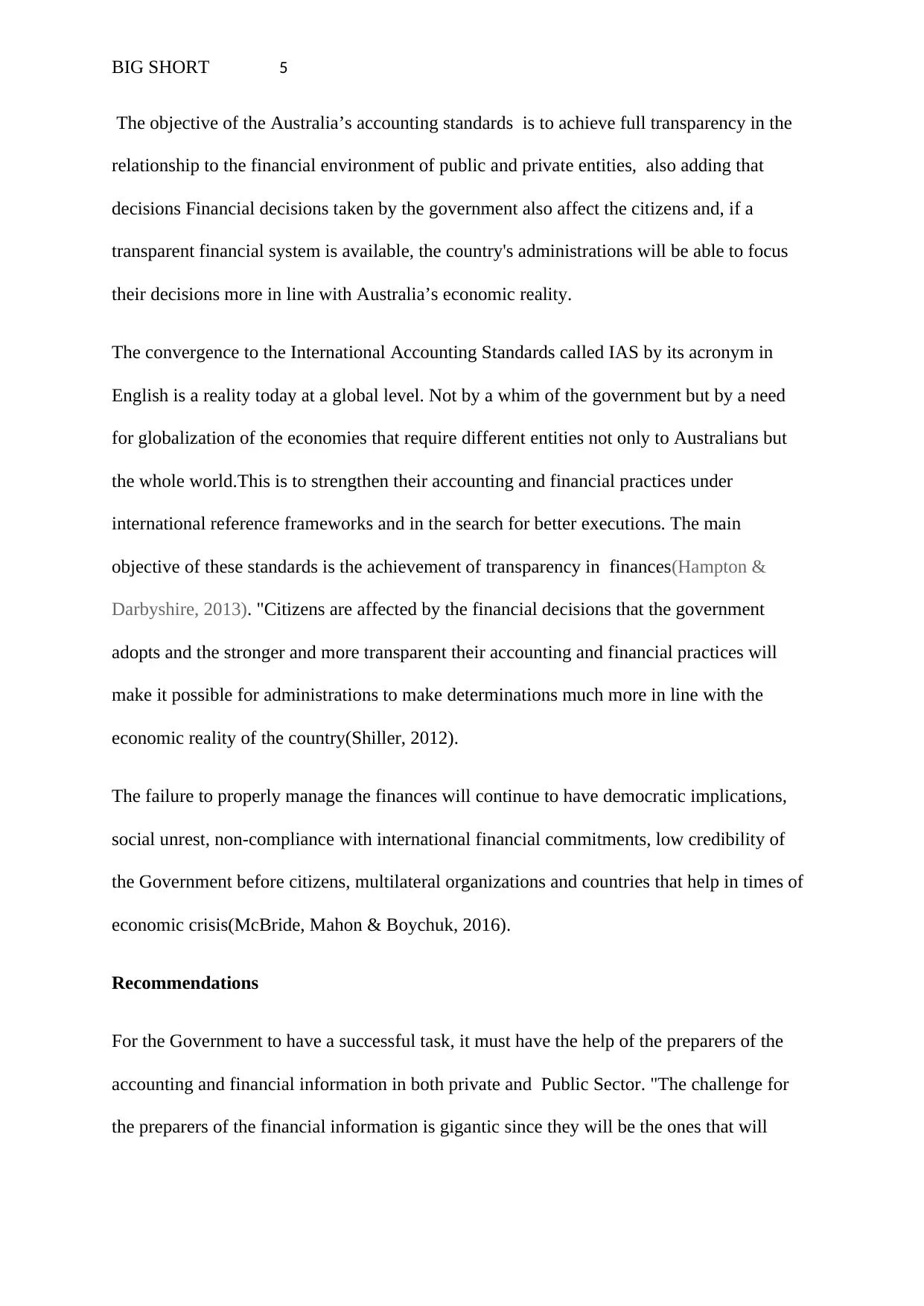
BIG SHORT 5
The objective of the Australia’s accounting standards is to achieve full transparency in the
relationship to the financial environment of public and private entities, also adding that
decisions Financial decisions taken by the government also affect the citizens and, if a
transparent financial system is available, the country's administrations will be able to focus
their decisions more in line with Australia’s economic reality.
The convergence to the International Accounting Standards called IAS by its acronym in
English is a reality today at a global level. Not by a whim of the government but by a need
for globalization of the economies that require different entities not only to Australians but
the whole world.This is to strengthen their accounting and financial practices under
international reference frameworks and in the search for better executions. The main
objective of these standards is the achievement of transparency in finances(Hampton &
Darbyshire, 2013). "Citizens are affected by the financial decisions that the government
adopts and the stronger and more transparent their accounting and financial practices will
make it possible for administrations to make determinations much more in line with the
economic reality of the country(Shiller, 2012).
The failure to properly manage the finances will continue to have democratic implications,
social unrest, non-compliance with international financial commitments, low credibility of
the Government before citizens, multilateral organizations and countries that help in times of
economic crisis(McBride, Mahon & Boychuk, 2016).
Recommendations
For the Government to have a successful task, it must have the help of the preparers of the
accounting and financial information in both private and Public Sector. "The challenge for
the preparers of the financial information is gigantic since they will be the ones that will
The objective of the Australia’s accounting standards is to achieve full transparency in the
relationship to the financial environment of public and private entities, also adding that
decisions Financial decisions taken by the government also affect the citizens and, if a
transparent financial system is available, the country's administrations will be able to focus
their decisions more in line with Australia’s economic reality.
The convergence to the International Accounting Standards called IAS by its acronym in
English is a reality today at a global level. Not by a whim of the government but by a need
for globalization of the economies that require different entities not only to Australians but
the whole world.This is to strengthen their accounting and financial practices under
international reference frameworks and in the search for better executions. The main
objective of these standards is the achievement of transparency in finances(Hampton &
Darbyshire, 2013). "Citizens are affected by the financial decisions that the government
adopts and the stronger and more transparent their accounting and financial practices will
make it possible for administrations to make determinations much more in line with the
economic reality of the country(Shiller, 2012).
The failure to properly manage the finances will continue to have democratic implications,
social unrest, non-compliance with international financial commitments, low credibility of
the Government before citizens, multilateral organizations and countries that help in times of
economic crisis(McBride, Mahon & Boychuk, 2016).
Recommendations
For the Government to have a successful task, it must have the help of the preparers of the
accounting and financial information in both private and Public Sector. "The challenge for
the preparers of the financial information is gigantic since they will be the ones that will
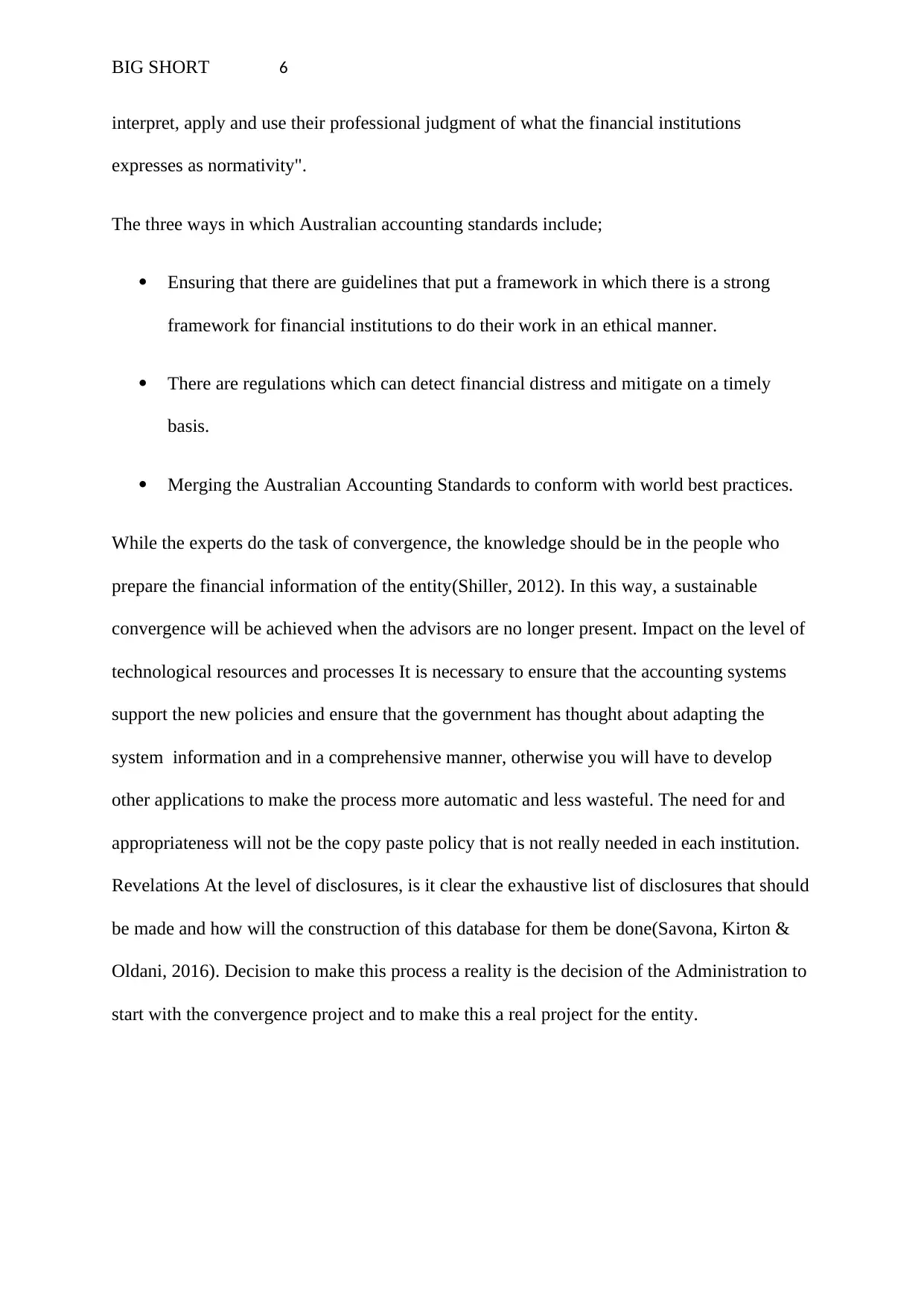
BIG SHORT 6
interpret, apply and use their professional judgment of what the financial institutions
expresses as normativity".
The three ways in which Australian accounting standards include;
Ensuring that there are guidelines that put a framework in which there is a strong
framework for financial institutions to do their work in an ethical manner.
There are regulations which can detect financial distress and mitigate on a timely
basis.
Merging the Australian Accounting Standards to conform with world best practices.
While the experts do the task of convergence, the knowledge should be in the people who
prepare the financial information of the entity(Shiller, 2012). In this way, a sustainable
convergence will be achieved when the advisors are no longer present. Impact on the level of
technological resources and processes It is necessary to ensure that the accounting systems
support the new policies and ensure that the government has thought about adapting the
system information and in a comprehensive manner, otherwise you will have to develop
other applications to make the process more automatic and less wasteful. The need for and
appropriateness will not be the copy paste policy that is not really needed in each institution.
Revelations At the level of disclosures, is it clear the exhaustive list of disclosures that should
be made and how will the construction of this database for them be done(Savona, Kirton &
Oldani, 2016). Decision to make this process a reality is the decision of the Administration to
start with the convergence project and to make this a real project for the entity.
interpret, apply and use their professional judgment of what the financial institutions
expresses as normativity".
The three ways in which Australian accounting standards include;
Ensuring that there are guidelines that put a framework in which there is a strong
framework for financial institutions to do their work in an ethical manner.
There are regulations which can detect financial distress and mitigate on a timely
basis.
Merging the Australian Accounting Standards to conform with world best practices.
While the experts do the task of convergence, the knowledge should be in the people who
prepare the financial information of the entity(Shiller, 2012). In this way, a sustainable
convergence will be achieved when the advisors are no longer present. Impact on the level of
technological resources and processes It is necessary to ensure that the accounting systems
support the new policies and ensure that the government has thought about adapting the
system information and in a comprehensive manner, otherwise you will have to develop
other applications to make the process more automatic and less wasteful. The need for and
appropriateness will not be the copy paste policy that is not really needed in each institution.
Revelations At the level of disclosures, is it clear the exhaustive list of disclosures that should
be made and how will the construction of this database for them be done(Savona, Kirton &
Oldani, 2016). Decision to make this process a reality is the decision of the Administration to
start with the convergence project and to make this a real project for the entity.
⊘ This is a preview!⊘
Do you want full access?
Subscribe today to unlock all pages.

Trusted by 1+ million students worldwide
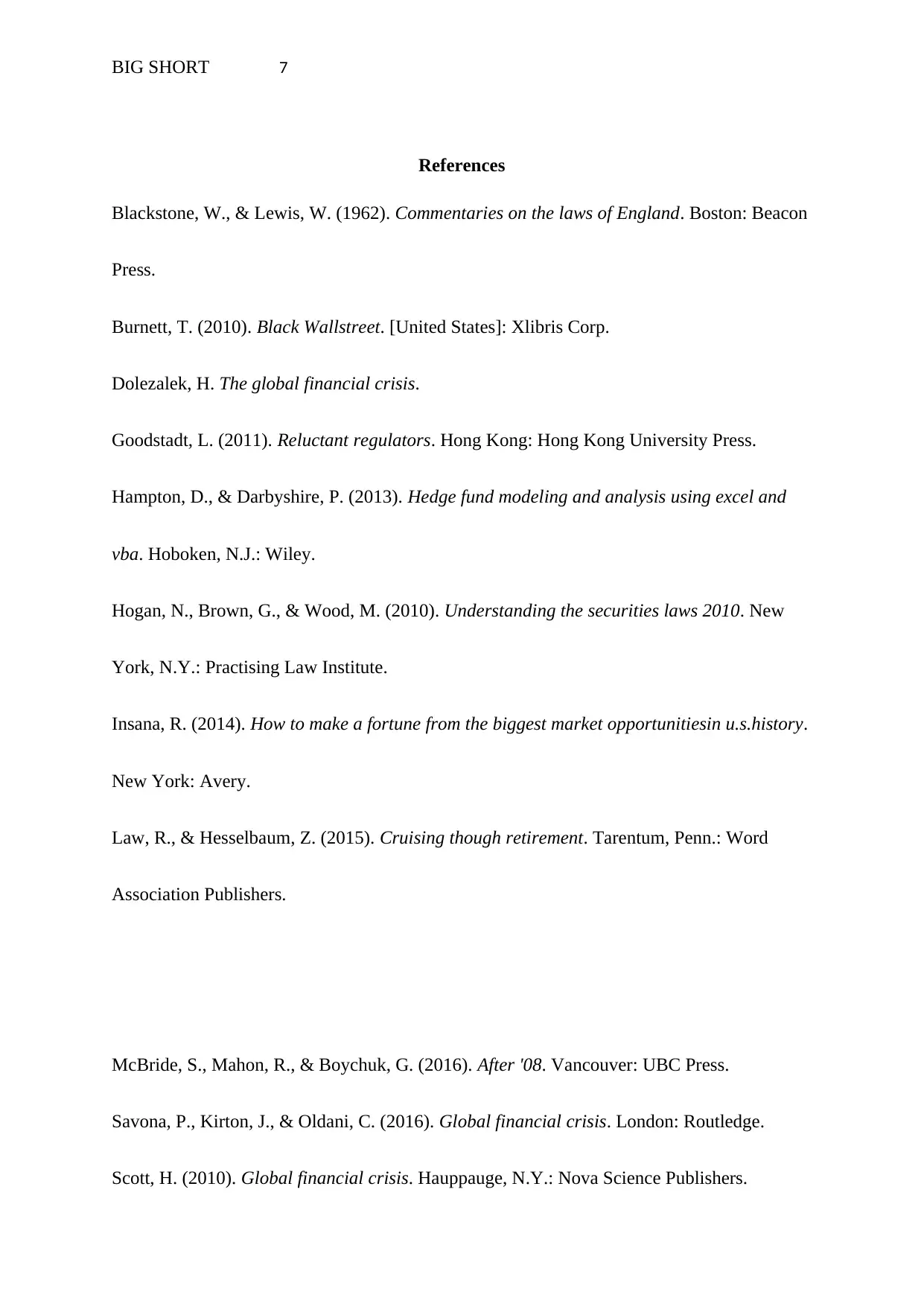
BIG SHORT 7
References
Blackstone, W., & Lewis, W. (1962). Commentaries on the laws of England. Boston: Beacon
Press.
Burnett, T. (2010). Black Wallstreet. [United States]: Xlibris Corp.
Dolezalek, H. The global financial crisis.
Goodstadt, L. (2011). Reluctant regulators. Hong Kong: Hong Kong University Press.
Hampton, D., & Darbyshire, P. (2013). Hedge fund modeling and analysis using excel and
vba. Hoboken, N.J.: Wiley.
Hogan, N., Brown, G., & Wood, M. (2010). Understanding the securities laws 2010. New
York, N.Y.: Practising Law Institute.
Insana, R. (2014). How to make a fortune from the biggest market opportunitiesin u.s.history.
New York: Avery.
Law, R., & Hesselbaum, Z. (2015). Cruising though retirement. Tarentum, Penn.: Word
Association Publishers.
McBride, S., Mahon, R., & Boychuk, G. (2016). After '08. Vancouver: UBC Press.
Savona, P., Kirton, J., & Oldani, C. (2016). Global financial crisis. London: Routledge.
Scott, H. (2010). Global financial crisis. Hauppauge, N.Y.: Nova Science Publishers.
References
Blackstone, W., & Lewis, W. (1962). Commentaries on the laws of England. Boston: Beacon
Press.
Burnett, T. (2010). Black Wallstreet. [United States]: Xlibris Corp.
Dolezalek, H. The global financial crisis.
Goodstadt, L. (2011). Reluctant regulators. Hong Kong: Hong Kong University Press.
Hampton, D., & Darbyshire, P. (2013). Hedge fund modeling and analysis using excel and
vba. Hoboken, N.J.: Wiley.
Hogan, N., Brown, G., & Wood, M. (2010). Understanding the securities laws 2010. New
York, N.Y.: Practising Law Institute.
Insana, R. (2014). How to make a fortune from the biggest market opportunitiesin u.s.history.
New York: Avery.
Law, R., & Hesselbaum, Z. (2015). Cruising though retirement. Tarentum, Penn.: Word
Association Publishers.
McBride, S., Mahon, R., & Boychuk, G. (2016). After '08. Vancouver: UBC Press.
Savona, P., Kirton, J., & Oldani, C. (2016). Global financial crisis. London: Routledge.
Scott, H. (2010). Global financial crisis. Hauppauge, N.Y.: Nova Science Publishers.
Paraphrase This Document
Need a fresh take? Get an instant paraphrase of this document with our AI Paraphraser
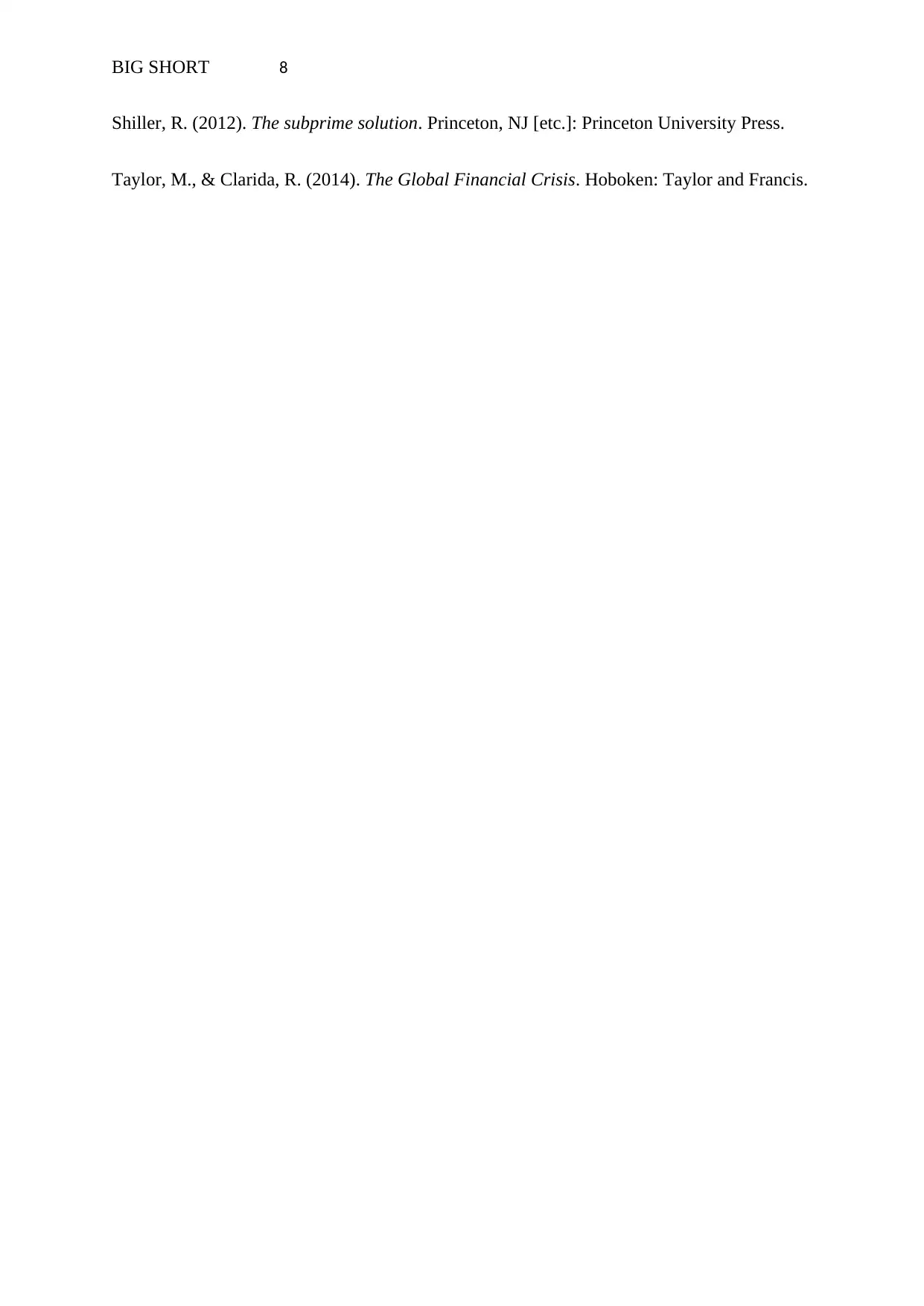
BIG SHORT 8
Shiller, R. (2012). The subprime solution. Princeton, NJ [etc.]: Princeton University Press.
Taylor, M., & Clarida, R. (2014). The Global Financial Crisis. Hoboken: Taylor and Francis.
Shiller, R. (2012). The subprime solution. Princeton, NJ [etc.]: Princeton University Press.
Taylor, M., & Clarida, R. (2014). The Global Financial Crisis. Hoboken: Taylor and Francis.
1 out of 8
Your All-in-One AI-Powered Toolkit for Academic Success.
+13062052269
info@desklib.com
Available 24*7 on WhatsApp / Email
![[object Object]](/_next/static/media/star-bottom.7253800d.svg)
Unlock your academic potential
Copyright © 2020–2025 A2Z Services. All Rights Reserved. Developed and managed by ZUCOL.


